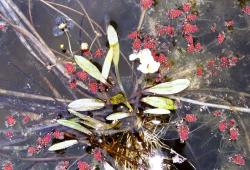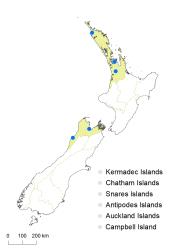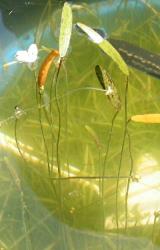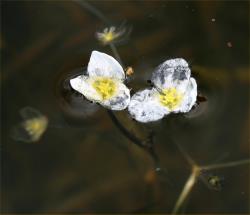- ≡ Alisma subulatum L., Sp. Pl. 343 (1753) – as subulata
Lax, perennial herb, with rosettes of floating or submersed leaves proliferating from stolons; corms present. Floating leaves shortly sheathing, petiolate; lamina 18–50 mm long, 3.5–12 mm wide, obovate or oblong, glabrous, base cuneate, apex obtuse or acute, margin entire; petioles 75–295 mm long, 1.5–4.0 mm wide, flattened, septate, glabrous. Submersed phyllodial leaves ribbon-like, with or without gradually expanding apices, ex-petiolate, 60–340 mm long, 3.0–10 mm wide, glabrous, obtuse or acute, margin entire. Inflorescence a whorled raceme, bracteate 50–80 mm long, 20–40 mm wide; 3–6 whorls of (2)–3 pedicellate flowers; scape 170–220 mm long, 1.0–3.0 mm wide, flattened, floating. Staminate flowers about 5–6 mm diameter, sterile carpels absent, pedicels spreading to ascending, 0.2–0.3 mm wide, terete; sepals 3–4 mm long, 1.5–2.0 mm wide, ovate, concavo-convex, with membranous margins; petals white, 3.0–6 .0 mm long, 2.0–5.0 mm wide, broad-elliptic or broad-ovate, with a short claw, apex obtuse, irregularly crenate; stamens 6; filaments 0.6–2.0 mm long, dilated, glabrous; anthers yellow, 0.6–0.8 mm long, elliptic. Carpellate flowers, carpels many, occasionally a ring of staminodes present, pedicels spreading, becoming recurved in fruit, 0.3–1.5 mm wide, distinctly thicker than staminate pedicels, terete; sepals 2.0–3.7 mm long, 1.0–2.8 mm wide, ovate, concavo-convex, with membranous margins, spreading to reflexed, not enclosing fruiting head, petals white, delicate, deciduous, 5.0–5.5 mm long, 3.6–4.2 mm wide, broad-ovate with a short claw, apex rounded. Fruiting head 5.5–8.0 mm diameter. Achenes 2.0–2.5 mm length, 1.0–1.5 mm wide, obovate with a lateral beak, winged, brown. Seeds 1.4–1.5 mm long, 0.6–0.8 mm wide, uncinate, yellow-brown.
A small, lax plant, which is mostly submersed, with ribbon-like leaves and small, unlobed obovate or oblong floating or emergent leaf-blades. Unlike Sagittaria montevidensis and S. platyphylla, the inflorescence is lax and floating rather than erect and emergent above the surface of the water. The flowers are much smaller than the other two species in New Zealand, only 5–6 mm in diameter for male flowers, compared with about 30 mm for S. montevidensis and 20 mm for S. platyphylla. The white flowers unfold just above the water surface and there is no coloured spot on the petals.
The submerged, ribbon-like leaves can be confused with Vallisneria australis and the submerged foliage of Ottelia ovalifolia (both Hydrocharitaceae). Ottelia ovalifolia plants are not stoloniferous and V. australis flowers are apetalous.
North Island: Auckland – Papakura Stream, Te Atatū, Waikato (Lake Waahi), Coromandel Peninsula (at Whenuakite, not seen since 1993, Paul Champion, pers. obs.).
South Island: Sounds-Nelson – Upper Moutere; Western Nelson – Buller, Westport.
Ponds, lakes, drains, stagnant or slow water-bodies.
CHR 455652, B. Menzies, Buller, Westport, 19 Feb. 1988.
Flowering: Dec.–Feb. Fruiting: Feb.–Apr.
2n = 22 (Uchiyama 1989).







